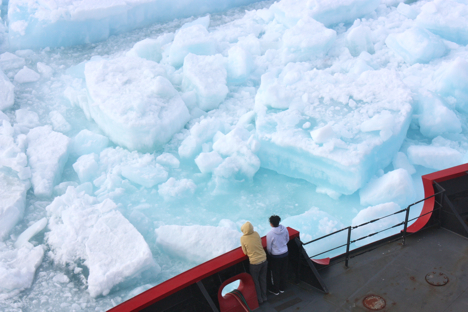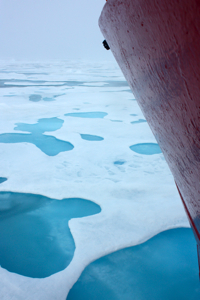July 8, 2011

ICESCAPE scientists watched from the deck of the Healy as it cut a path through thicker multiyear ice on July 6, 2011. Cutting the path is key for getting researchers to remote research sites amid the sea ice. Credit: NASA/Kathryn Hansen
Our home on the Healy is a noisy one. Engines constantly hum, the fog horn can’t be missed (particularly from staterooms on the third deck), and loudspeakers broadcast the latest Coast Guard drill. Perhaps the most relevant sound on an icebreaker, however, is the sound of breaking ice.

On July 7, I took a trip down into the bowels of the Healy’s bow to record the sound of the ship’s hull pummeling through thin, first-year ice (mp3 above). The rhythm and crescendos reminded me of the percussion section of an amateur orchestra.
Interestingly, icebreaking sounds completely different depending on your location in the ship. From outside on the ship’s deck you can hear the ice cracking and ocean water rushing in to fill the void. From inside in the science lounge, add the effect of vibrating bookshelves and the demise of items not properly secured.
These sounds (not to mention the earthquake-like movement) eventually blend into the background and sleep comes easily. The strange part will be returning home at the end of the month to a “quiet and still” life in the city.
By now you might be wondering, how much ice can the Healy break? Cruising at 3 knots, the ship is rated to break 4.5 feet of ice. By backing and ramming, the ship can break through 8 feet. Breaking thicker ice is possible but would take more time. Find more information here.

